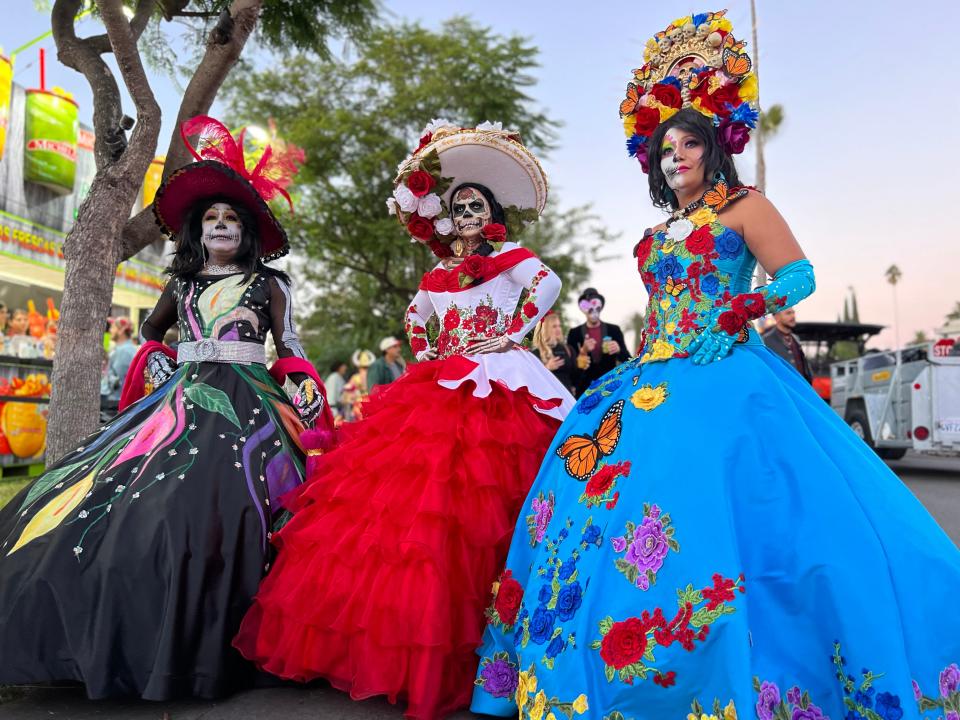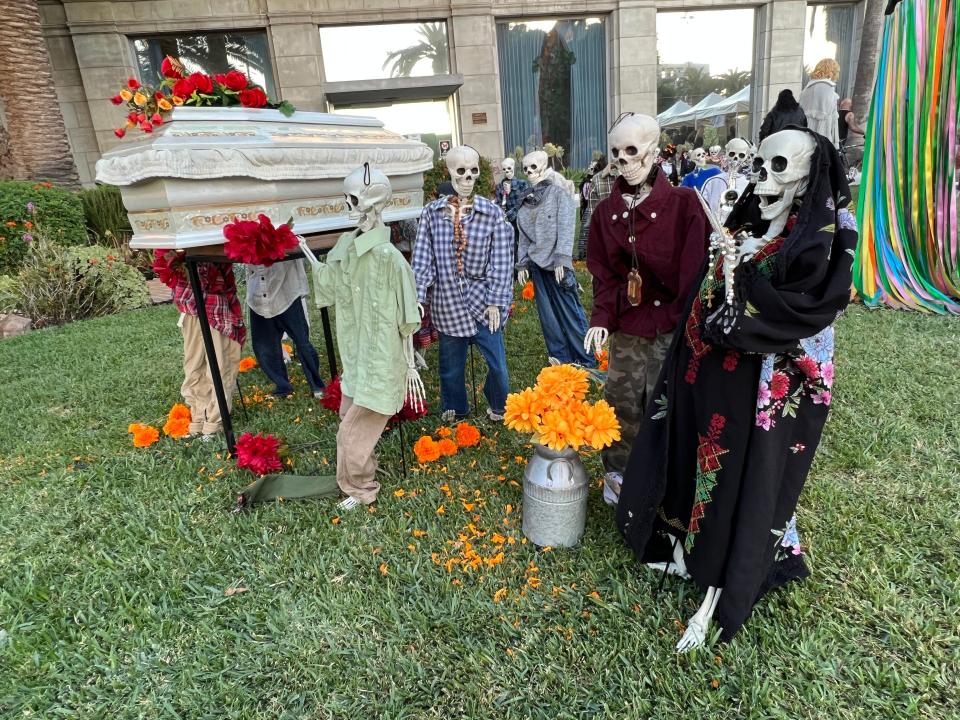Deceased loved ones will continue to live in the hearts of those who remember them, but one very special holiday honors the life they led on Earth.
In late October, or so the tradition says, the souls of loved ones return from the afterlife to celebrate and spend time with living relatives on Día de los Muertos, or Day of the Dead, which is typically observed on Nov. 1 and 2.
Families, friends and admirers of the deceased prepare ofrendas, or altars, to welcome their loved ones, including pets, back home. The holiday also happens to coincide directly with Catholic holidays All Saint’s Day and All Soul’s Day.
“I feel like this Mexican tradition gives people the opportunity to see death in a different way,” Angie Jimenez, director of the altar program at Hollywood Forever Cemetery in Los Angeles previously told USA TODAY.
The annual tradition has been recognized by Indigenous civilizations in Mexico for over 3,000 years. Elements of Catholicism and Christianity were later incorporated into the Indigenous death ritual after the colonization of the Aztec empire by the Spanish in the 16th century, for a holiday shaped by the ideas, beliefs and motifs of the Spanish, Christian and Indigenous civilizations.
Despite the origins of the holiday being rooted in Mexico, the tradition of honoring a loved one who has passed has been embraced by many the world over, with many major celebrations in the U.S.

Who does Day of the Dead celebrate?
Anyone you want to remember, including family members, friends, pets or even celebrities.
When is Day of the Dead, Día de los Muertos, celebrated?
Day of the Dead festivities usually take place Nov. 1 and 2, depending on the age of the deceased person you are honoring. But sometimes celebrations can kick off as early as Halloween night.
Nov. 1 is commonly referred to as the Día de los Inocentes (Day of the Innocent), or Día de los Angelitos (Day of the Little Angels). It typically honors the lives of young children or young people. Nov. 2 is known as Día de los Muertos and Día de los Difuntos, in which loved ones commemorate the lives of adults who have passed.
The separate remembrances not only acknowledge the different stages of life but provide a specific focus for each day, reflecting a blend of indigenous Aztec beliefs and Catholic traditions, according to The Arizona Republic, part of the USA TODAY Network.
The construction of an altar or a gravesite decoration session can occur even earlier, depending on the region.
“I would say that most people, you could really say, celebrate it for a week or multiple weeks. Because many people don’t make the ofrenda on Nov. 1, they don’t make it on Oct. 31, they don’t make it on Nov. 2. They make it weeks in advance of the actual holiday,” Mathew Sandoval, a professor at Arizona State University researching Día de los Muertos, shared with The Republic.
Mexico City, for example, celebrates Day of the Dead throughout the month of October, allowing people to add or change up their altars over the course of the month.
Though the holiday is largely observed by people in Mexico and Mexican American or Latino communities in the United States, Bolivia, Ecuador, Peru, Guatemala, and even Haiti celebrate Day of the Dead in their own way, according to The Mexican Museum in association with the Smithsonian Institution.
Where is Day of the Dead celebrated?
Day of the Dead can really be celebrated anywhere an altar has been made, Jimenez shared. Ofrendas have been built in homes, parks, grocery stores and gravesites.
Families or friends use the days to gather with one another to construct an altar, visit the graves of loved ones, use paint to create a skull-like figure on their face, dress up, make sugar skulls, swap stories, share food, enjoy music or dance, purchase marigolds and attend a parade or festival.


What is a Day of the Dead ofrenda?
An ofrenda, or altar, is created with the attention of providing a physical space for the spirit of the family member, friend, or pet you want to be reunited with again.
Most altars incorporate yellow marigolds, candles, photos of the deceased, papel picado, or cut tissue-paper designs, as well as food and beverage offerings for the dead, according to The Mexican Museum in association with the Smithsonian Institution.
Skulls, or calaveras, are commonly used decorations. They be made of papier-mâché, clay, wood, metal, cut-out tissue paper, and often, they are made of sugar decorated with colored icing, flowers, or metallic colored foils.
The components integrated into the altar will vary depending on the culture, region, preference.


Since the altar is the “heart and soul” of what Día de los Muertos is all about, it’s important to include traditional elements like candles, papel picado, a beverage, or food, Jimenez shared. All of these items represent the four elements of nature.
As long as you have the traditional components, the location of the altar and its size don’t matter, Jimenez said.
The altar should also be unique to the person whose soul you are interested in reconnecting with, so adding a few personal touches like their favorite snacks, toys, or belongings can’t hurt.
Here are a few things you might want to include in yours:


How has Day of the Dead changed over the years?
Traditions, like anything else, are subject to changes or modifications as time marches on.
Day of the Dead has gone through transitions of how it’s celebrated and honored since the time of the Aztec people, but one key element has stayed the same. The living have a chance to visit with the departed for two days out of the year in a joyous and rather colorful celebration of life.
One of the most unique aspects of Dia de los Muertos is the ambiguity of how it evolved to what it is today, Ramona Pérez, anthropology professor and director of the Center for Latin American Studies at San Diego State University, previously told USA TODAY.


Colorful altars, dressing in traditional Mexican formal wear, sugar skull face-painting and masks are some of the most distinguishable displays of reverence for the Día de los Muertos traditions.
Opting into these optional practices is a way to pay homage to the cultural significance of the holiday. One of the most iconic Day of the Dead symbols, La Calavera Catrina, an elegant skull, was created by satirical cartoonist José Guadalupe Posada in 1910. The illustration depicted a skeleton dressed in fashionable attire to mock the upper class of that time.
Over the last century, La Catrina has been embraced as a symbol of Mexican culture and has come to represent the idea that death is an inherent part of life and should be celebrated, according to reporting by The Republic.
It has become common to see people wearing La Catrina-inspired costumes or paint their faces to resemble the skeletal features of La Catrina, rocking elaborate dresses, suits, flower crowns, shawls or hats to form a complete look.
“They’re just a reminder of our own mortality. We are all going to the same space,” Jimenez said. “Although it might sound very dark or morbid, it’s a statement on how death is just as beautiful as life.”
A previous version of this story was published in 2023.
Contributing Jordan Mendoza
This article originally appeared on USA TODAY: What is Day of the Dead? What to know about the Mexican tradition















